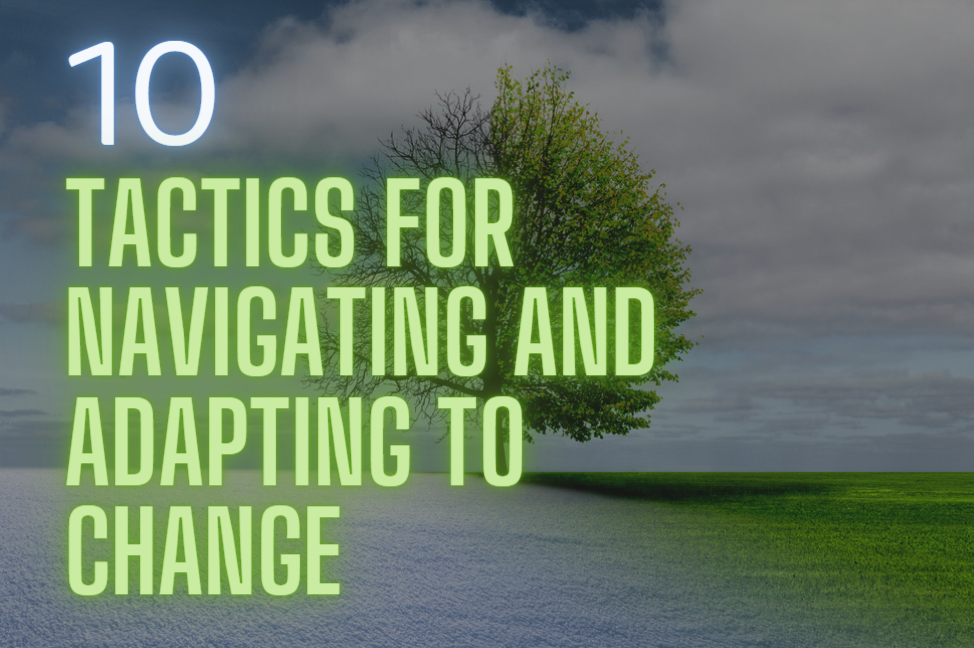Introduction
You’re facing change—it’s inevitable. But how you handle it can make all the difference.
In this guide, you’ll discover 10 powerful tactics to adapt and thrive amidst life’s twists and turns. From embracing a growth mindset to building resilience, we’ve got you covered.
Learn to pivot with poise, maintain a positive outlook, and emerge stronger.
Ready to take control? Let’s dive in and transform the way you navigate change starting today!
Embrace a Growth Mindset
To adapt and thrive amid change, you’ll need to cultivate a growth mindset that welcomes challenges as opportunities for development. This mindset shift isn’t just about positive thinking; it’s about actively seeking out and embracing situations that push your boundaries. When you encounter obstacles, don’t view them as impassable walls, but rather as hurdles that you’re capable of overcoming.
Incorporating challenge acceptance into your daily life means recognizing that setbacks are an integral part of learning and growth. Instead of avoiding difficulties, you’ll start to approach them with curiosity, asking yourself, ‘What can I learn from this experience?’ This attitude turns the fear of failure into the fuel for progress, driving you to experiment, to adapt, and to evolve.
Cultivate Flexibility
As you face the inevitable twists and turns of your professional landscape, it’s crucial to embrace uncertainty with open arms.
Cultivating a flexible mindset allows you to adjust your strategies and maintain momentum amidst change.
Let’s explore how you can develop adaptation strategies that keep you agile and prepared for whatever comes your way.
Embrace Uncertainty
In the face of uncertainty, you’ll find your footing by nurturing flexibility in your approach to change. This means developing uncertainty acceptance as a core skill. It’s about learning to expect the unexpected and not just reacting, but proactively engaging with the unknown. By doing so, you’re not caught off guard; instead, you’re equipped to handle whatever comes your way.
Risk anticipation is another key element. It’s not about fearing what could go wrong, but rather being aware and preparing accordingly. You can’t predict the future, but you can create strategies that are adaptable and resilient. So, when change inevitably comes knocking, you won’t be thrown off course. You’ll adjust, pivot, and keep moving forward, turning uncertainty into a landscape of possibilities.
Flex Mindset
With a flex mindset, you’ll adapt to new situations more readily, embracing change as an opportunity for growth rather than a setback. This attitude is essential in cultivating change readiness.
You’ll find that being open to flexible approaches allows you to maneuver through life’s twists and turns with greater ease. Instead of resisting new ideas, you’ll learn to pivot and incorporate them into your strategies. By doing so, you stay relevant and capable of facing the unexpected.
Adaptation Strategies
You’ll harness resilience by developing a suite of adaptation strategies that enable you to remain flexible in the face of change. Cultivating change readiness is essential; it’s about preemptively embracing the mindset that change is inevitable and can be positive. You’ve got to anticipate shifts and adapt your strategies accordingly.
Becoming an early adopter of innovation can keep you ahead of the curve. Don’t shy away from new technologies or methodologies; instead, assess their potential impact on your goals and integrate them when beneficial. Innovation adoption isn’t just about tools and tech—it’s a mindset that values continuous improvement and learning.
Develop Resilience
You’ll find that building mental toughness is a cornerstone of resilience. It’s about weathering the storm, not just waiting for the sun.
Build Mental Toughness
Amidst life’s inevitable changes, building mental toughness empowers you to bounce back from setbacks more effectively. Overcoming setbacks isn’t just about pushing through; it’s about strengthening your mind. Mental exercises play a crucial role in this process, equipping you with the resilience needed to handle future challenges.
To hook you into the journey of building your mental toughness, consider these strategies:
- Practice mindfulness: Cultivate awareness and presence to reduce stress.
- Set small, achievable goals: Build confidence through consistent wins.
- Embrace challenges: View obstacles as opportunities for growth rather than threats.
Practice Adaptive Thinking
After honing your mental toughness, it’s time to delve into practicing adaptive thinking, a skill that’ll enable you to navigate change with resilience. Fostering change readiness is essential; it’s about proactively preparing for the unknown rather than reacting when it hits.
Start by challenging your usual way of doing things. Ask yourself, ‘Is there a better way?’ This mindset paves the way for innovative thinking, which is the cornerstone of adaptability.
Your ability to bounce back from setbacks depends on how quickly you can shift gears and come up with creative solutions. So, embrace flexibility in your thought process. Look for opportunities in every change, and don’t be afraid to pivot your strategy.
Prioritize Continuous Learning
To stay ahead in a constantly evolving world, you must prioritize continuous learning. Embracing lifelong learning isn’t just a nice-to-have; it’s essential for keeping your skills fresh and relevant. As the pace of change accelerates, skill updating becomes an ongoing necessity rather than a one-off event. You’re not just acquiring knowledge for today; you’re investing in your ability to adapt and excel tomorrow.
Consider these strategies to make continuous learning a seamless part of your life:
- Set clear, achievable goals: Identify specific skills or knowledge areas you want to develop and set realistic milestones to keep yourself on track.
- Leverage diverse learning resources: From online courses to podcasts, expand your learning toolkit to include a variety of formats that fit your lifestyle and preferences.
- Create a learning community: Engage with peers who share your commitment to growth. This can provide mutual support and accountability.
By integrating these practices into your routine, you’ll find that continuous learning becomes less of a chore and more of an exciting opportunity to enhance your capabilities.
Stay curious, stay adaptable, and watch as your efforts open doors to new possibilities and career advancements.
Strengthen Your Support Network
Building a robust support network is crucial as you navigate the unpredictable waves of change. The people you surround yourself with can provide invaluable perspectives, emotional backing, and practical assistance. It’s time to actively cultivate those social connections that uplift and support you.
Start by reaching out. Don’t wait for others to make the first move. Send a text, make a call, or schedule a coffee date. Be intentional about maintaining old friendships while being open to forming new ones. And remember, it’s not just about the number of connections you have, but the quality of those interactions that matters.
Engage with your community, too. Community engagement puts you in touch with like-minded individuals who share your interests or passions. Join local groups, volunteer, or attend events that resonate with you. These experiences don’t just enrich your personal life; they can also expand your professional network.
Set Realistic Expectations
As you face change, it’s essential to set realistic expectations for yourself to prevent disappointment and maintain motivation. It’s a balancing act—aim high enough to inspire progress but stay grounded to avoid setting yourself up for a fall. Expectation management isn’t just a buzzword; it’s a strategy for aligning your goals with the reality of your situation.
To give you a head start, here’s what you can focus on:
- Understand your limits: Acknowledge that you’re human and that you have both strengths and weaknesses.
- Break it down: Set smaller, achievable milestones that pave the way to larger objectives.
- Flexibility is key: Be ready to adjust your goals as circumstances evolve.
Remember, acceptance practice is part of setting realistic expectations. It means embracing the present moment, including the uncertainties that come with change. You won’t always control the outcome, but you can control your reaction and adapt your approach accordingly.
Practice Mindfulness and Adaptability
Embracing mindfulness, you’ll equip yourself to better handle the ebbs and flows of change with a calm and focused approach. Through quiet reflection, you gain clarity on what truly matters to you, which in turn helps you to adapt more smoothly to new circumstances. This self-awareness is a critical component of your change embrace arsenal.
By practicing mindfulness, you train yourself to remain present and attentive, even amidst uncertainty. This skill allows you to respond to change rather than react impulsively. It’s about observing your thoughts and emotions without judgment and understanding that they don’t have to dictate your actions. When you’re mindful, you open yourself up to a world of possibilities, making adaptability not just a necessity, but a natural response.
Plan for Multiple Scenarios
In planning for change, you’ll benefit from considering various potential outcomes and preparing for each scenario. This approach, known as scenario planning, isn’t about predicting the future; it’s about creating a strategic map that helps you navigate through different possibilities. By envisioning a range of scenarios, you’re not caught off guard; instead, you’re equipped with contingency plans that can pivot and adapt as circumstances evolve.
To hook your interest, consider these benefits of planning for multiple scenarios:
- Increased resilience: By preparing for various outcomes, you’re less likely to be derailed by unexpected events.
- Strategic agility: Flexible plans mean you can respond quickly and effectively, no matter what the future holds.
- Better decision-making: Understanding potential scenarios helps you make informed choices, balancing risks and opportunities.
Future proofing methods go hand in hand with scenario planning. They’re about building a business or career that can withstand shocks and stresses, whatever their source. As you plan, remember to think broadly and creatively. What if the market shifts dramatically? What if a new technology disrupts your industry? By considering these ‘what-ifs’, you’re not just surviving change – you’re positioning yourself to thrive.
Maintain a Positive Attitude
While you’re preparing for various scenarios, don’t underestimate the power of maintaining a positive attitude throughout these changes. An optimistic outlook can be your most reliable ally when the winds of change blow fiercely. It’s more than just feeling good; it’s about creating an environment where positivity breeds more positivity.
Here’s the deal: your mindset directly influences your resilience. By focusing on positive reinforcement, you’re not ignoring the difficulties ahead; you’re empowering yourself to tackle them head-on. When you’re optimistic, you’ll find that solutions come to you more readily. You’ll see opportunities where others see dead ends.
Remember, it’s not just about you. Your positive attitude has a ripple effect, inspiring those around you. When you’re optimistic, you encourage your team to be the same, creating a culture of can-do spirit that’s infectious.
So, how do you maintain this attitude? Start by recognizing your achievements, however small. Celebrate the wins and learn from setbacks without letting them define you. Surround yourself with positive influences and don’t be afraid to lean on them when you need a boost.
Embrace change with a smile, and you’ll soon find that the path ahead, while uncertain, is full of potential. Stay positive, and you’ll not only adapt but thrive.
Reflect and Reassess Regularly
As you face change, it’s crucial to pause and reflect on your progress.
Assess whether your goals still align with your evolving situation and consider adjusting your strategies accordingly.
Regularly reviewing your approach ensures you’re always moving in the right direction.
Continuous Self-Evaluation
You’ll need to regularly reflect on your actions and reassess your strategies to effectively navigate change. By engaging in self reflection techniques, you can gain insights into your own behavior and decision-making processes.
Meanwhile, harnessing various evaluation tools can help quantify your progress and pinpoint areas for improvement.
To hook you in, consider the following:
- *Identify patterns*: Recognize recurring behaviors that either aid or hinder your adaptability.
- *Set measurable goals*: Use benchmarks to track your development and stay motivated.
- *Solicit feedback*: Embrace constructive criticism from peers to refine your approach.
Goal Adjustment Strategies
Every goal you set should be subject to regular review, ensuring it still aligns with the evolving landscape you’re navigating. Change readiness isn’t just about anticipating shifts; it’s also about being willing to adjust your aims when necessary.
Don’t be rigid. If you notice that a goal no longer serves your purpose or the context has dramatically shifted, it’s time for a strategy pivot. Reflect on your progress periodically, and ask yourself if your goals are still relevant and achievable.
Reassessing your objectives means you’re actively managing your direction, rather than being at the mercy of change. By fine-tuning your goals, you’re not giving up on them; you’re making sure they’re still the right fit for the journey ahead.
Periodic Strategy Review
Strategy reassessment, a key component of your adaptive toolkit, ensures you’re always aligned with the shifting tides of change. Change management isn’t a one-off process; it requires continuous attention and fine-tuning.
By incorporating a periodic strategy review into your routine, you’ll be able to:
- Identify new opportunities or risks early on
- Adjust your course to align with evolving goals or market conditions
- Foster a culture of agility and proactive decision-making
Review frequency is crucial—don’t wait for annual reports to reflect on your strategy’s effectiveness. Regular check-ins, perhaps quarterly or even monthly, enable you to stay on top of changes and pivot swiftly when necessary.
Frequently Asked Questions
How Do I Handle the Sense of Loss That Comes With Change, Especially When It Involves Leaving Behind Parts of My Identity or Career?
You’re facing a tough time, grappling with identity mourning and career transition. It’s normal to feel a sense of loss when you’re leaving behind familiar parts of yourself.
But remember, you’re not alone. Embrace the change, find support, and give yourself time to adjust.
You’ll soon find new aspects of your identity and career to celebrate. Keep moving forward, and you’ll adapt and find fulfillment in this new chapter of your life.
Can You Provide Examples of How Specific Cultural or Organizational Contexts Might Impact the Tactics for Navigating Change?
You’re facing change, and it’s crucial to consider your environment. In a tight-knit community, cultural adaptability means respecting traditions while introducing new ideas.
At work, organizational resilience might involve cross-training teams to handle shifts smoothly. Each setting demands unique approaches; embrace them, and you’ll find your way through the transitions.
How Do I Navigate Changes That Seem to Conflict With My Personal Values or Ethical Boundaries?
When changes clash with your values or ethics, it’s crucial to engage in value alignment and ethical navigation.
You’ll need to assess the situation and determine if there’s room for compromise without sacrificing your core principles.
If the conflict is too great, speak up or seek roles that better align with your ethics.
Balancing adaptation and integrity is tough, but you must prioritize what feels right for you in the long run.
What Are Some Strategies for Dealing With Resistance to Change From Team Members or Peers, Especially When I Am Leading the Change Initiative?
When you’re leading a change initiative and face resistance, it’s crucial to focus on change communication. You’ve got to clearly articulate the reasons and benefits of the shift.
Engage in empathy exercises—put yourself in their shoes to understand their concerns. Address their fears directly, and offer support throughout the transition.
Keep the dialogue open and listen actively. It’s about guiding them, not pushing, to ensure everyone is on board and moving forward together.
How Does One Cope With the Uncertainty and Anxiety That Comes With Prolonged Periods of Change, Such as Industry Disruptions or Long-Term Societal Shifts?
You’re dealing with constant change, and it’s natural to feel anxious. To cope, start by embracing uncertainty. It’s about shifting your mindset.
Acknowledge the stress but don’t let it paralyze you. Instead, see change as an opportunity for growth. Stay flexible and proactive.
Connect with others facing similar challenges, and remember, you’re not alone.
Conclusion
You’ve got what it takes to ride the waves of change. Embrace growth, flex with the times, and build resilience.
Keep learning, lean on your network, and stay mindful. Plan, but be ready to pivot.
Keep your head up and your outlook bright. Regularly take stock of your journey. Change isn’t just something you endure—it’s an opportunity to flourish.
Adapt and thrive, because you’re more than capable of navigating the shifting sands of life.





